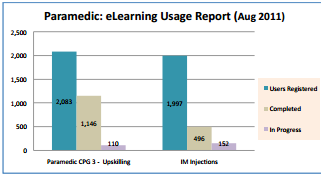eLearning Progress Update
PHECCs involvement in e‐learning is spread over 5 separate projects. The initial investment was in supplying Internet enabled PCs to all HSE and DFB ambulance stations. We are awaiting a status report on this from the CPR in UL. This initial investment was an enabling initiative to support the learning modules. To date the following have been developed and deployed:
- Paramedic CPG 3 Upskilling
- IM Injection Module
- AP Upskilling Modules 1 & 2
- Web casts (Spin off from AP modules)
- CFR 2011 instructor Upskilling Mo
The following report summarises usage of the
e-learning modules to 30 Aug 2011.

Paramedic Upskilling - Evaluation
Question 1: I found the training programme easy to navigate and understand.

Question 2: I think e-learning is a good way of obtaining such information.

Question 3: I thought the use of video, interactive elements and voice-over really helped bring the programme to life and put the training points across.

Question 4: I would be interested in doing more upskilling courses through the medium of e-learning.

Question 5: I think the programme gave me a sound level of training in the subject matter.

The response of registrants to the e-learning initiatives has been overwhelmingly positive. It delivers material directly and is a key building block for practitioner professionalism. The evaluation report on AP engagement in e-learning is very reassuring. Exploitation of electronic information resources and new media will be a key element in future development of the EMS profession.
|
|
AP Module Evaluation (Survey Results - Extract)
Advanced Paramedics are prepared to take responsibility for their own education and appreciate the ability to schedule their own learning time with 93.3% appreciating the opportunity to review foundation information during the module.
Advanced Paramedics clearly want to be challenged by e-learning and are requesting more interactivity. They also want to be tested on completion with 93% indicating the importance of a final test after completion of the modules.
eLearning can influence behaviour and lead to changes in clinical practice - 91.1% of respondents indicated that they intend to change aspects of their practice due to information contained in the module.
The evaluation of this project provides direct evidence that pre-hospital practitioners have responded positively to e-learning.
A new method of receiving learning has been introduced to a target group where 100% of survey respondents agreed that they have benefited from the information deliveredand 95.6% indicated that they would like to complete modules like this on a regular basis. Proposed additional modules for development and roll out in the future are:
- EMT CPG 3 and Ilcor upskilling
- Paramedic Ilcor upskilling
- AP modules 3-5
- Web casts
|
“I can’t use a computer – How am I supposed to do the upskilling?”
PHECC’s online upskilling package was developed to allow practitioners access upskilling at a time and place of their choosing. In anticipation of any difficulties with availability of computers in the stations, and in addition to the PCs previously made available by us, we funded the purchase of a multimedia PC for each statutory ambulance station in the country. While the older PC may be slow or unserviceable by now, the new one should be available to practitioners in any HSE or DFB ambulancestation. If for any reason you choose not to use the station PC then the use of the PC facility in any public library is a recommended alternative.
The upskilling package is designed to accommodate all levels of end-user technological ability. It is presented as both intuitive and easy to use but also backed by a dedicated help desk to talk practitioners through any issues they are experiencing. This ‘belt and braces’ approach is proving to be extremely successful with technical ability becoming less of a challenge for practitioners as they embrace the technology.
Peer support is another approach being suggested for those with difficulty gaining access to the online package. Practitioners can ask a colleague in their station to show them how to turn on and start the programme. Anecdotally, this method is commonly used by DFB and HSE staff and overcomes the access problem. A final suggestion is that in service training staff should be asked to demonstrate how the system works.
EMS staff who have encountered difficulties have been able to overcome them through a combination of the above approaches and have gone on to successfully complete the
programme. |
|